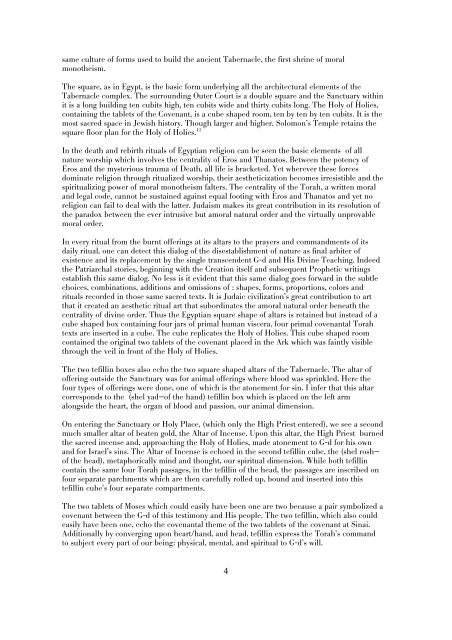SECTION 1 - via - School of Visual Arts
SECTION 1 - via - School of Visual Arts
SECTION 1 - via - School of Visual Arts
Create successful ePaper yourself
Turn your PDF publications into a flip-book with our unique Google optimized e-Paper software.
same culture <strong>of</strong> forms used to build the ancient Tabernacle, the first shrine <strong>of</strong> moral<br />
monotheism.<br />
The square, as in Egypt, is the basic form underlying all the architectural elements <strong>of</strong> the<br />
Tabernacle complex. The surrounding Outer Court is a double square and the Sanctuary within<br />
it is a long building ten cubits high, ten cubits wide and thirty cubits long. The Holy <strong>of</strong> Holies,<br />
containing the tablets <strong>of</strong> the Covenant, is a cube shaped room, ten by ten by ten cubits. It is the<br />
most sacred space in Jewish history. Though larger and higher, Solomon’s Temple retains the<br />
square floor plan for the Holy <strong>of</strong> Holies. 11<br />
In the death and rebirth rituals <strong>of</strong> Egyptian religion can be seen the basic elements <strong>of</strong> all<br />
nature worship which involves the centrality <strong>of</strong> Eros and Thanatos. Between the potency <strong>of</strong><br />
Eros and the mysterious trauma <strong>of</strong> Death, all life is bracketed. Yet wherever these forces<br />
dominate religion through ritualized worship, their aestheticization becomes irresistible and the<br />
spiritualizing power <strong>of</strong> moral monotheism falters. The centrality <strong>of</strong> the Torah, a written moral<br />
and legal code, cannot be sustained against equal footing with Eros and Thanatos and yet no<br />
religion can fail to deal with the latter. Judaism makes its great contribution in its resolution <strong>of</strong><br />
the paradox between the ever intrusive but amoral natural order and the virtually unprovable<br />
moral order.<br />
In every ritual from the burnt <strong>of</strong>ferings at its altars to the prayers and commandments <strong>of</strong> its<br />
daily ritual, one can detect this dialog <strong>of</strong> the disestablishment <strong>of</strong> nature as final arbiter <strong>of</strong><br />
existence and its replacement by the single transcendent G-d and His Divine Teaching. Indeed<br />
the Patriarchal stories, beginning with the Creation itself and subsequent Prophetic writings<br />
establish this same dialog. No less is it evident that this same dialog goes forward in the subtle<br />
choices, combinations, additions and omissions <strong>of</strong> : shapes, forms, proportions, colors and<br />
rituals recorded in those same sacred texts. It is Judaic civilization’s great contribution to art<br />
that it created an aesthetic ritual art that subordinates the amoral natural order beneath the<br />
centrality <strong>of</strong> divine order. Thus the Egyptian square shape <strong>of</strong> altars is retained but instead <strong>of</strong> a<br />
cube shaped box containing four jars <strong>of</strong> primal human viscera, four primal covenantal Torah<br />
texts are inserted in a cube. The cube replicates the Holy <strong>of</strong> Holies. This cube shaped room<br />
contained the original two tablets <strong>of</strong> the covenant placed in the Ark which was faintly visible<br />
through the veil in front <strong>of</strong> the Holy <strong>of</strong> Holies.<br />
The two tefillin boxes also echo the two square shaped altars <strong>of</strong> the Tabernacle. The altar <strong>of</strong><br />
<strong>of</strong>fering outside the Sanctuary was for animal <strong>of</strong>ferings where blood was sprinkled. Here the<br />
four types <strong>of</strong> <strong>of</strong>ferings were done, one <strong>of</strong> which is the atonement for sin. I infer that this altar<br />
corresponds to the (shel yad—<strong>of</strong> the hand) tefillin box which is placed on the left arm<br />
alongside the heart, the organ <strong>of</strong> blood and passion, our animal dimension.<br />
On entering the Sanctuary or Holy Place, (which only the High Priest entered), we see a second<br />
much smaller altar <strong>of</strong> beaten gold, the Altar <strong>of</strong> Incense. Upon this altar, the High Priest burned<br />
the sacred incense and, approaching the Holy <strong>of</strong> Holies, made atonement to G-d for his own<br />
and for Israel’s sins. The Altar <strong>of</strong> Incense is echoed in the second tefillin cube, the (shel rosh—<br />
<strong>of</strong> the head), metaphorically mind and thought, our spiritual dimension. While both tefillin<br />
contain the same four Torah passages, in the tefillin <strong>of</strong> the head, the passages are inscribed on<br />
four separate parchments which are then carefully rolled up, bound and inserted into this<br />
tefillin cube’s four separate compartments.<br />
The two tablets <strong>of</strong> Moses which could easily have been one are two because a pair symbolized a<br />
covenant between the G-d <strong>of</strong> this testimony and His people. The two tefillin, which also could<br />
easily have been one, echo the covenantal theme <strong>of</strong> the two tablets <strong>of</strong> the covenant at Sinai.<br />
Additionally by converging upon heart/hand, and head, tefillin express the Torah’s command<br />
to subject every part <strong>of</strong> our being: physical, mental, and spiritual to G-d’s will.<br />
4








